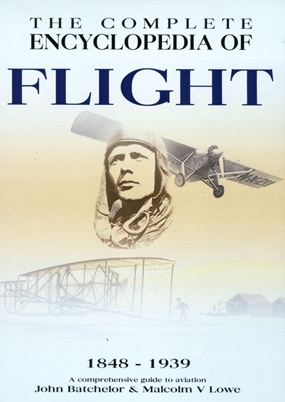Many years ago I had a Maiden Aunt who had been a member of the WAF (Women’s Air Force), who gave me a wonderful book on aviation, and she inscribed it with the words, “Hoping you enjoy planes as much as I have done.”
I did find planes interesting, but they never caught my imagination as much as some other boyhood interests. However, when I saw The Complete Encyclopedia of Flight (1848-1939) (ISBN 13: 978-90-366-1600-3, Rebo International, 2006) on the Bookazine shelves it rekindled my interest.

The Complete Encyclopedia of Flight (1848-1939) was illustrated by John Batchelor and the text from Malcolm V Lowe. When the Wright brothers were the first to make a powered flight with a pilot, I was somewhat taken aback that this encyclopedia should start in 1848. Only by reading the introduction you are introduced to people such as John Stringfellow, who made steam engine powered gliders (but no pilot) and Sir George Cayley who made some very advanced gliders in the mid-1800’s, which carried a boy, and later another one which carried his terrified coachman, the first recorded flight of a man in 1853. So, the book reveals many people who pre-dated the Wright brothers, but did not manage powered flight, under the control of a pilot, as did the Wrights in 1903.
After the introduction, the individual planes are examined and there are notes covering the builder, any war experience with the plane and other items of interest including specifications. This covers details such as Charles Lindbergh’s flight from New York to Paris in 1927, 4,210 nautical miles covered in thirty three and a half hours, solo.
Many of the planes and their manufacturers I had never heard of, which made the encyclopedia even more interesting. For example, Breguet, Cierva Autogyros, Caudron, Santos-Dumont, Friedrichshafen, Hansa Brandenburg and even an Albatross. Of course there are makes which most of us have heard of, including the German Junkers, Caproni, Dornier, Fokker, De Havilland, Hawker, and of course the Spitfire gets its rightful place, as does Von Richthofen, the Red Baron, with his famous ‘dreidecker’ Fokker triplane.
Fascinating history such as Boeing, which began making planes in 1916, and how when the rudimentary planes went to war in 1914, the machine gunner could saw off his own propeller until natty machines were invented to time the bullets to go between the blades. There was even one idea which deflected the bullets at 45 degrees, to miss the prop, and probably missed all the enemy planes as well.
The book looks at sea planes as well as the more usual undercarriage, and I did not know that Amundsen tried to reach the North Pole in a Dornier Wal seaplane.
At B. 630 this is an excellent reference source. Gloss pages, beautifully printed, hard cover – everything an aviation enthusiast would want. It is as promised on the front cover, a comprehensive guide to aviation between 1848 and 1939. My Maiden Aunt, long since departed to the airfields in the sky would have been most impressed, by both the book, and my enjoyment of it.




